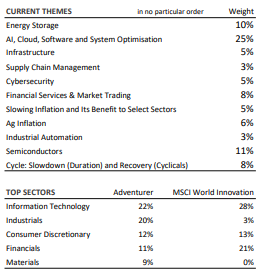I occasionally plan to feature interesting emerging managers I come across. This is different from my usual content focused on Big Bay Street. The tone is also different, focusing more on information, rather than infotainment.
The founder of the eponymous Bouthillier Capital is part of a new wave of Canadian emerging managers who have international pedigree. Mathieu Bouthillier has a Masters degree in Economics, with a specialization in finance, from the University of Edinburgh and has worked for JP Morgan in London. Before going on his own at Bouthillier Capital, better known as B-CAP, he worked for 8 years at BMO Nesbitt Burns managing money for high net worth clients.
B-CAP was founded in 2020 and has been officially managing money since January 2021. The firm has already attracted the support of some leading lights in the Montreal finance community as clients. It is registered in Quebec and Ontario. As part of a push into the institutional market, B-CAP has also constituted a board of advisors and added a financial director. Mathieu is himself a director of the Emerging Managers Board, an industry group. Last fall, B-CAP added a partner, Jean-François Gagnon, a 30-year veteran who previously ran a research-intensive long/short strategy at Fiera and Natcan before that.
At Nesbitt Burns, Mathieu quarterbacked his advisory team with deep research, analysis and a focus on investment strategy. B-CAP is a continuation of this rigorous work. The core philosophy is to invest systematically, minimizing discretionary decisions and the impact of emotions. Quantitative factors that drive investment return, such as total shareholder yield and return on equity are emphasized.
While B-CAP is a traditional full-service wealth management firm, its focus is on pioneering innovative investments strategies. The firm operates three equity-focused strategies in managed accounts: Defence, Adventurer and GTBT (for Good Times Bad Times, after the Led Zeppelin song).
Strategy #1 Defence, benefiting from rising dividends
The Defence portfolio bets on sustainable dividend growth in large-cap stocks using quantitative filters. Sustainability is evaluated via various factors such as historical and projected growth in revenue per share, profit margins, free cash flow, return on equity, and maintaining a reasonable debt level. The notion of moat is also a major consideration. The Defence model adopts a long-term investment horizon of 5-10 years and focuses on stocks issued by companies with a minimum of $1 billion in market cap, with the majority exceeding $5B in size. The strategy uses the MSCI World High Dividend index as benchmark.
B-CAP published a white paper in March 2024 explaining the underpinnings of the Defence strategy.
The Defence strategy has performed well in the three years since inception. In 2022, it was down 5.49%, while it was up double digits in 2023 and 2024. So far, it lives up to the “defence” label.
You can see some broad portfolio parameters as of the end of 2024:

Strategy #2: Adventurer
The Adventurer strategy should be thought of as a higher torque strategy. It takes a thematic approach. Following launch in 2021, it had major exposure to the energy sector and then starting in the second half of 2021, it rotated into the IT and software sectors. Within the macro and thematic view, stocks are selected based on a mix of quantitative fundamental factors and qualitative analysis.
The strategy has considerable flexibility with a maximum ceiling on sector exposure of 40%. It can invest anywhere from small to large caps. The Adventurer strategy has outperformed its benchmark, the MSCI Innovation index to date.
You can see some of the current themes and sectors below:

Strategy #3: Good Times Bad Times, the all-weather strategy
This all-weather strategy, named after the Led Zeppelin song, takes into account the macro picture, market sentiment and technical factors. It can invest in both stocks and bonds and uses various sub-strategies. It is an opportunistic, unconstrained strategy that can go both long and short.
The strategy has 8 main determinants as part of its decision process:
1) Position in the economic cycle
2) Factors (ie ‘factor investing’)
3) Quantitative and qualitative data on industries
4) Street estimates vs potential
5) Fear vs greed
6) Market positioning
7) Corporate activity
8) Technical Analysis
The goal of the GTBT strategy is to generate positive 12-month returns in any market environment.
Fees
For the two long-only strategies, fixed fees start at 0.90% for the first million, then 0.65% for assets above $1m. For accounts above $5m, there's a simple 0.60% fee. Those are very competitive fees. B-CAP doesn't charge a performance fee on the long-only strategies, but does charge one on the GTBT strategy. This is subject to a hurdle rate of 10% (calculated net of the management fee). The management fee of the GTBT strategy starts at 1.5%.
Building a firm for the long-term
Mathieu is a big fan of Ray Dalio, founder of Bridgewater Associates. He likes in particular his “relentless, educated recalibration of strategies, global multi-asset approach, rigor and serenity.” Another major influence is Howard Marks, founder of Oaktree Capital. He respects in particular his humility about what’s knowable in the markets.
Although I am primarily a believer in buy-and-hold strategies myself, it's reasonable to surmise that B-CAP's other strategies will benefit from a scenario where markets mean-revert from their high returns in the past 15 years. I have attended B-CAP events and gotten to know the founder. Like most CIO-types, his strength is in the craft of investing. Mathieu has a strong understanding of academic finance. The summaries I have provided above probably don’t do justice to all the thinking that goes into B-CAP’s strategies. When I ask him questions about his strategies, it leads to answers that are several paragraphs long. But Mathieu is also a methodical business builder. He is active sponsoring all kinds of community events, including a junior hockey team. He brings some marketing acumen and versatile operations skills, which are key in growing assets and building a sustainable business.